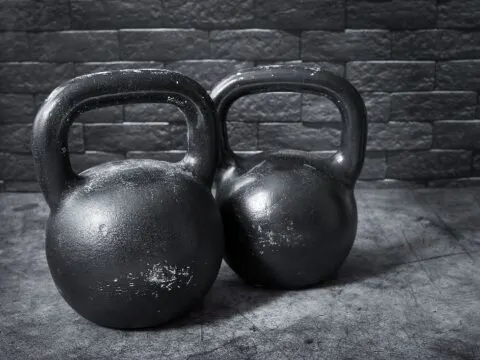Some of the links in this post are affiliate links. This means if you click on the link and purchase the item, we will receive an affiliate commission from the vendor at no extra cost to you. These business relationships allow us to keep bringing you great EatMoveHack content. All opinions remain our own.
Whether you’re establishing your first exercise routines on the road to better health or would like to mix up your existing workouts by trying something new, kettlebells offer easy but interesting routines that can benefit your entire body. Getting started with kettlebells is fairly easy: You just need to find one that’s heavy enough to be challenging, but not so heavy as to cause injury. As for how to use kettlebells, all you have to do is learn the various parts of the weight and then follow simple instructions to complete exercises that will work your midsection, arms, shoulders, legs, and more.
Keep reading to learn why kettlebells are an excellent choice for building muscle, bettering your balance, and strengthening your core. And then check out our top exercise picks for all the info on how to use a kettlebell to work out specific parts of your body.
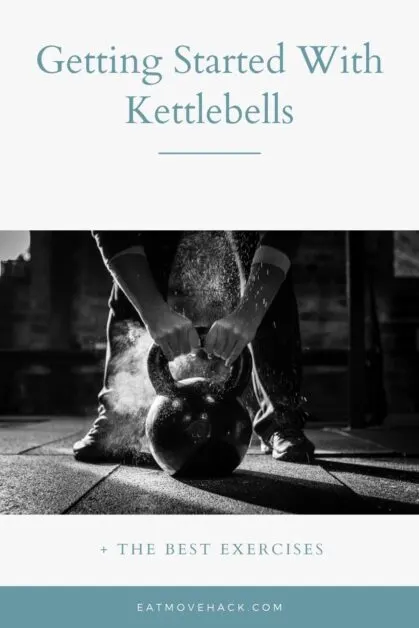
Kettlebell 101
Before getting started with kettlebells, it’s important to learn about the various parts of the weight so that you’ll understand what part to grasp when performing different exercises. Here’s what they’re called:
- Bell — The bell is the round, cannon-ball-like part of the kettlebell. Sometimes referred to as the base, it’s the heaviest part of the weight.
- Horns —The horns are the extensions that come from the bell. They get their name from the fact that they resemble a bull’s horns.
- Handle — The handle is the straight handhold that’s directly opposite of the bell. Handle thickness may fluctuate with the overall weight of the kettlebell, so it’s important to choose a weight with a handle that’s narrow enough to comfortably grasp.
- Window — The window is the open area directly above the bell. You have to insert your fingers through the window to grasp the kettlebell by the horns or handle.
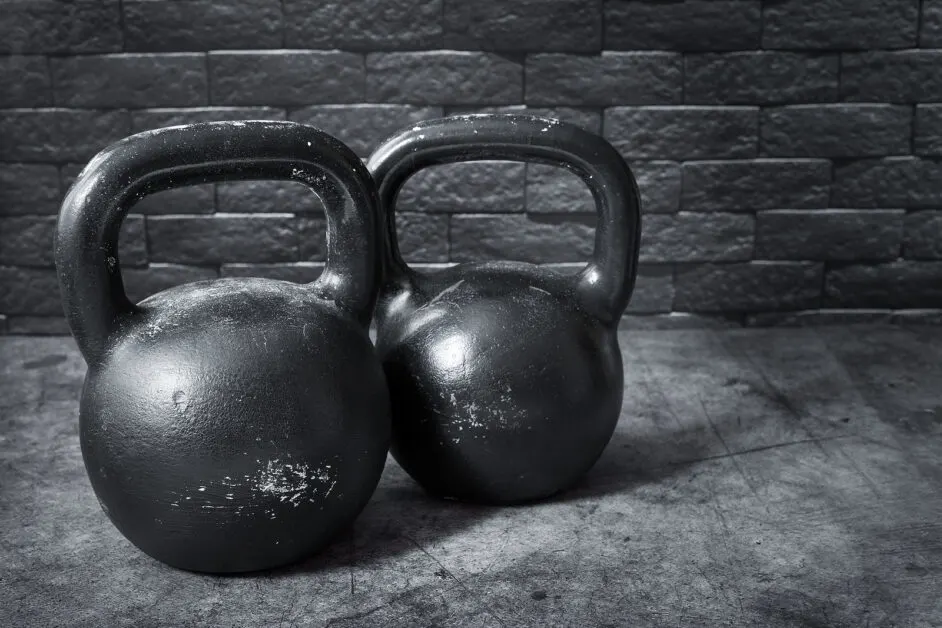
How to Use Kettlebells
Kettlebell exercises can be classified as grinds or ballistics based on the type of movement you perform.
Grinds are slower, more controlled exercises, like presses and curls. While maintaining proper form is important for all routines, they’re easier to achieve with grinds due to the focus for which they allow.
As the name suggests, ballistic exercises are those that allow for more explosive or powerful movements. Routines that involve swinging the kettlebell or otherwise using your body to create momentum fall into this category.
Kettlebells are designed to be grasped from all parts. Which handhold you’ll use depends largely on the exercise you’re completing. For example, for overhead presses, you’ll generally hold the kettlebell from the handle, while grabbing the weight from the horns or bell offers greater control during squats.
These weights are available in many sizes, typically starting at 5 lbs and increasing in 5 lb increments to about 100 lbs. Depending on your experience level and strength, your starting kettlebell should weigh between 20 and 35 lbs. Before committing, try a few reps with the kettlebell to be sure it challenges you but doesn’t overwhelm you.
Benefits of Training with Kettlebells
Kettlebells might look like simple, unassuming pieces of exercise equipment, but they’re extremely versatile and allow you to get in some reps at a moment’s notice.
One of the biggest benefits of using kettlebells is that you can start with just one. Depending on the exercises you like to do, you may only ever require a single piece.
Due to their relatively small size and the types of exercises you can do, kettlebells allow you to enjoy a full-body workout in less space. This is perfect if you’re working out in a crowded gym or only have a small area at home to dedicate to exercising.
Thanks to their compact shape and how easy they are to hold, kettlebells allow you to maintain excellent form while completing routines. In most cases, you’ll notice that your movements are smooth and controlled. If you feel pain or an unnaturalness to your motions, there’s a good chance you’re doing the exercise wrong.
In terms of physical health, working out with kettlebells will improve your balance and strengthen your core because many routines exercise your midsection, even if you’re concentrating on other parts of your body, such as your shoulders or legs.
Training with Kettlebells
The following are a variety of basic and classic exercises that are perfect for anyone, whether you’re just starting with kettlebells or are looking for new exercises to work into your routine.
Before starting, be sure to thoroughly stretch and warm up to prevent strain and injury.
Do 10 reps of each exercise to complete a circuit. Depending on your strength and energy levels, complete 5 to 10 circuits, resting about 60 seconds between each.
Kettlebell Swing
Strengthens midsection, hamstrings, and glutes
- Using both hands, grasp the kettlebell from the handle.
- Separate your feet until they’re hip-width apart.
- Raise your hands until you’re holding the kettlebell directly in front of you.
- Bend your knees and push your hips backwards, swinging the kettlebell between your legs as you go down.
- Stand up, tightening your glutes, pushing forward with your hips, and swinging the kettlebell upward to chest level.
- Immediately start the rep over, bending your knees and swinging the kettlebell between your legs.
- Throughout the exercise, maintain control of the kettlebell. Don’t swing the kettlebell wildly; instead, control it’s descent and ascent using your arms.
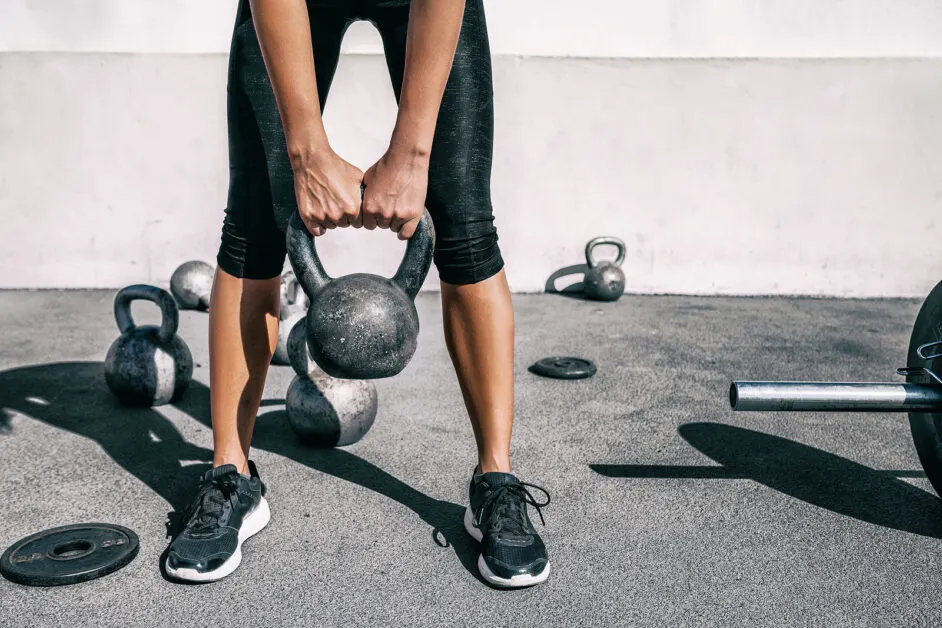
Single-Arm Staggered Stance Row
Strengthens midsection, arms, shoulders, and upper back
- Grasp the kettlebell by the handle using your left hand, and then take one step forward.
- Bend your knees, dropping your left knee lower so that you can rest your right arm just above your right knee.
- Ensure that your hips are pushed back, your back is straight, and your midsection is tightened.
- Slowly lift the kettlebell, pulling your elbow up past your back.
- Hold the position for two seconds, and then lower the kettlebell until your arm is fully extended. The up-and-down motion will look similar to pumping a handle.
- Complete one circuit using your left arm, and then switch positions to work your right arm.
Overhead Push Press
Strengthens midsection, legs, shoulders, and triceps
- Grasp the kettlebell by the handle using your left hand.
- Separate your feet until they’re hip-width apart.
- Bring the kettlebell up, and hold it at your shoulder.
- Extend your right arm away from your body to maintain balance through the routine.
- Slightly bend your knees and push back your hips to complete a half squat. Keep the kettlebell at your shoulder through the squat.
- Stand back up to the starting position.
- As soon as your knees are straightened, push the weight over your head by pumping your arm upward.
- Fully extend your arm upward and stand tall — don’t lean to compensate for the weight above your head.
- Hold the position for two seconds, and then lower the kettlebell to the starting position.
- Complete one circuit using your left arm, and then switch positions to work your right arm.
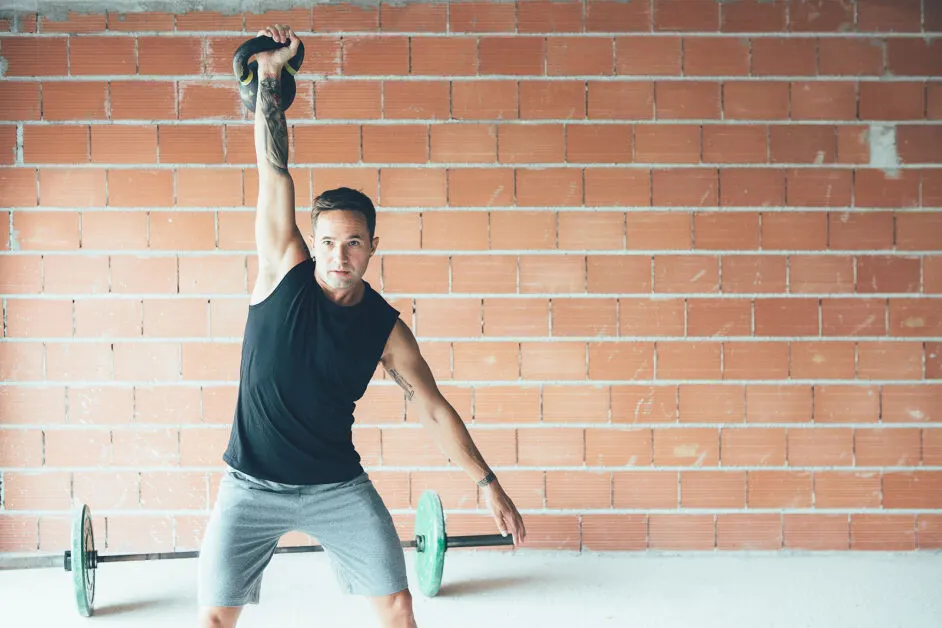
Goblet Squat
Strengthens midsection, legs, and glutes
- Grasp the kettlebell by the horns using both hands and bring it to your chest, with the bell facing the floor. Keep your elbows tucked close to your body, and tighten your midsection.
- Separate your feet until they’re hip-width apart, and turn your toes until they’re facing outwards just a bit.
- Bend your knees and lower your butt until you’re in a squat position.
- Hold the position for five seconds, ensuring that you keep your back straight.
- Push yourself back up to a standing position.
Squat and Curl
Strengthens midsection, legs, upper back, and biceps
- Grasp the kettlebell by the horns using both hands and bring it to your chest, with the bell closest to your chin. Keep your elbows tucked close to your body, and tighten your midsection.
- Separate your feet until they’re hip-width apart, and turn your toes until they’re facing outwards just a bit.
- Bend your knees and lower your butt until you’re in a squat position.
- Slowly extend your elbows, lowering the kettlebell until it almost touches the floor. This move is called a bicep curl.
- Bring the kettlebell back up to your chest, and then push yourself back up to a standing position.
Triceps Extension
Strengthens arms, shoulders, and midsection
- Grasp the kettlebell by the horns using both hands, with the bell facing the floor.
- Separate your feet until they’re hip-width apart, and tighten your midsection.
- Raise the kettlebell directly over your head until your arms are fully extended.
- Slowly bend your elbows, lowering the kettlebell behind your head until the weight nearly touches your back.
- Hold the position for two seconds, and then fully extend your arms to raise the kettlebell back over your head.
- During this exercise, take note that only your forearms should be moving; try to keep your upper arms locked in place.
Kettlebell exercises are fun, dynamic, and challenging ways to work out muscles throughout your body and improve your overall core strength. Best of all, getting started with kettlebells is easy — you only need one at the beginning, and you can expand your collection as you build strength and try new routines.
Looking for other exercises that don’t require a lot of space or equipment? Try a superman plank or burpees.

